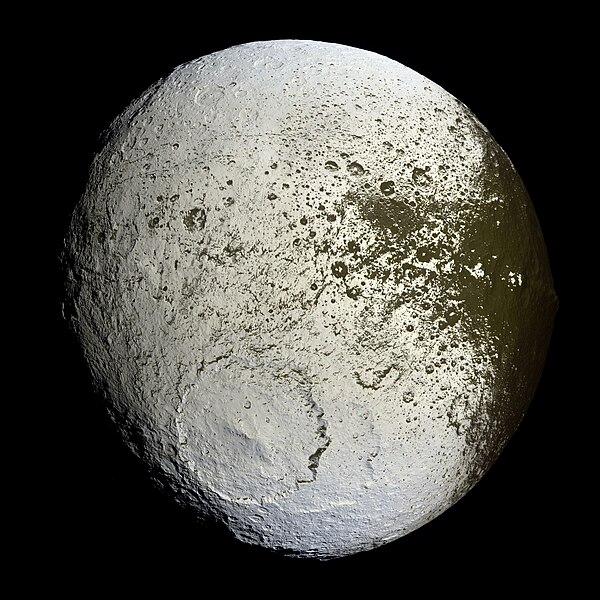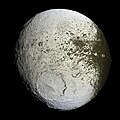Ficheiro:Iapetus as seen by the Cassini probe - 20071008.jpg

Dimensões desta antevisão: 600 × 600 píxeis. Outras resoluções: 240 × 240 píxeis | 480 × 480 píxeis | 768 × 768 píxeis | 1 024 × 1 024 píxeis | 2 048 × 2 048 píxeis | 4 032 × 4 032 píxeis.
Ficheiro original (4 032 × 4 032 píxeis, tamanho: 6,22 MB, tipo MIME: image/jpeg)
Histórico do ficheiro
Clique uma data e hora para ver o ficheiro tal como ele se encontrava nessa altura.
| Data e hora | Miniatura | Dimensões | Utilizador | Comentário | |
|---|---|---|---|---|---|
| atual | 18h07min de 12 de dezembro de 2018 |  | 4 032 × 4 032 (6,22 MB) | Kesäperuna | 100% JPEG quality from full quality TIFF, slightly cropped to be more centered. |
| 09h18min de 9 de outubro de 2007 |  | 4 100 × 4 100 (1,56 MB) | Startaq | {{Information |Description = Cassini captures the first high-resolution glimpse of the bright trailing hemisphere of Saturn's moon Iapetus. This false-color mosaic shows the entire hemisphere of Iapetus (1,468 kilometers, or 912 miles across) visible fro |
Utilização local do ficheiro
As seguintes 2 páginas usam este ficheiro:
Utilização global do ficheiro
As seguintes wikis usam este ficheiro:
- Uso no domínio af.wikipedia.org
- Uso no domínio an.wikipedia.org
- Uso no domínio ar.wikipedia.org
- Uso no domínio ary.wikipedia.org
- Uso no domínio arz.wikipedia.org
- Uso no domínio ast.wikipedia.org
- Uso no domínio az.wikipedia.org
- Uso no domínio ba.wikipedia.org
- Uso no domínio be.wikipedia.org
- Uso no domínio bg.wikipedia.org
- Uso no domínio bn.wikipedia.org
- Uso no domínio bn.wikibooks.org
- Uso no domínio bs.wikipedia.org
- Uso no domínio ca.wikipedia.org
- Uso no domínio ckb.wikipedia.org
- Uso no domínio cs.wikipedia.org
- Uso no domínio cv.wikipedia.org
- Uso no domínio cy.wikipedia.org
- Uso no domínio de.wikipedia.org
Ver mais utilizações globais deste ficheiro.




